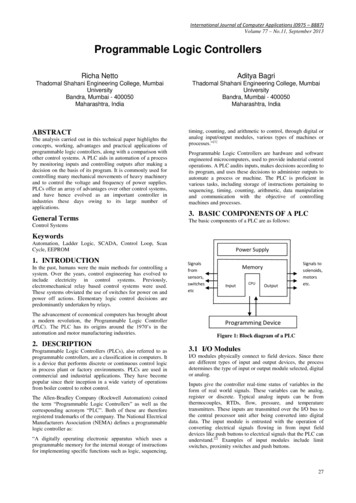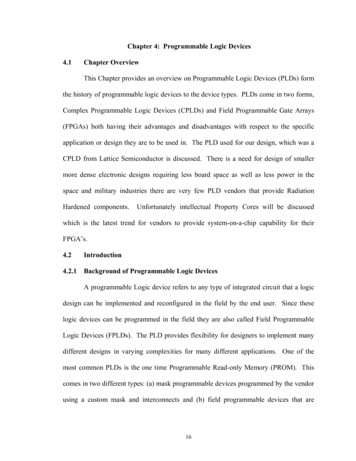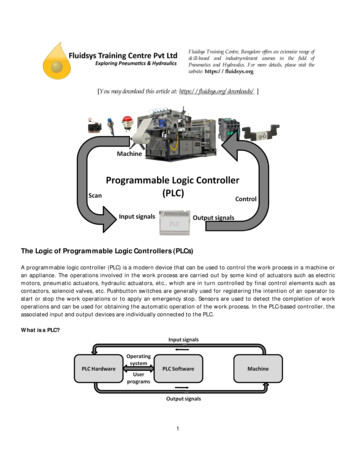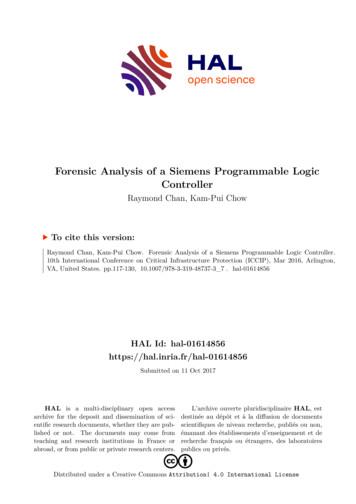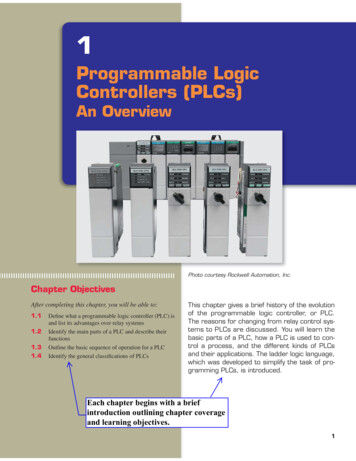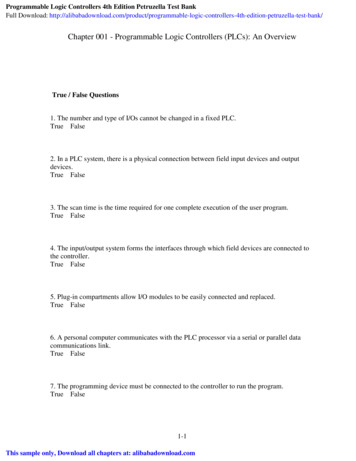
Transcription
Programmable Logic Controllers 4th Edition Petruzella Test BankFull Download: hapter 001 - Programmable Logic Controllers (PLCs): An OverviewTrue / False Questions1. The number and type of I/Os cannot be changed in a fixed PLC.True False2. In a PLC system, there is a physical connection between field input devices and outputdevices.True False3. The scan time is the time required for one complete execution of the user program.True False4. The input/output system forms the interfaces through which field devices are connected tothe controller.True False5. Plug-in compartments allow I/O modules to be easily connected and replaced.True False6. A personal computer communicates with the PLC processor via a serial or parallel datacommunications link.True False7. The programming device must be connected to the controller to run the program.True False1-1This sample only, Download all chapters at: alibabadownload.com
Chapter 001 - Programmable Logic Controllers (PLCs): An Overview8. PLC systems usually require as much space in an enclosure as equivalent hardwired relaysystems.True False9. A PLC is basically a computer designed for use in electrical control applications.True False10. The programmable controller operates in real time.True False11. One disadvantage of modular I/O is its lack of flexibility.True False12. A PLC power supply module does not normally supply power to the field devices.True False13. Removing the programming device from the PLC will not affect the operation of the userprogram.True False14. Software installed and run on a personal computer can be used to write a PLC program.True False15. The instruction set for a particular PLC lists the types of instructions supported.True False1-2
Chapter 001 - Programmable Logic Controllers (PLCs): An Overview16. When dealing with PLC memory, one K of memory represents 1024.True False17. The number of I/O points does not affect the memory size required for a PLC installation.True FalseMultiple Choice Questions18. PLCs were originally designed as replacements for:A. microcomputers.B. relay control panels.C. analog controllers.D. digital controllers.19. Basically, the function of a PLC is to:A. amplify various weak signal sources.B. control a high voltage output with a low voltage input.C. control the speed of motors.D. make logical decisions and control outputs based on them.20. Modifying relay-type process control circuits usually involves changing the:A. circuit wiring.B. input circuit modules.C. output circuit modules.D. circuit operating voltage levels.1-3
Chapter 001 - Programmable Logic Controllers (PLCs): An Overview21. Which of the following is not an advantage that PLCs offer over the conventional relaytype of control system?A. Smaller sizeB. Less expensiveC. Higher current capacityD. More reliable22. The main difference between a PLC and relay control system is that:A. different types of input devices are used.B. different types of output devices are used.C. different input and output voltage levels are used.D. one uses hardwired relay control logic and the other uses programmed instructions.23. The central processing unit:A. looks at the inputs, makes the decisions based on the program, and sets the outputs.B. looks at the outputs, makes the decisions based on the program, and sets the inputs.C. serves only to store the program in memory.D. serves only to supply power to the backplane.24. PLC proprietary architecture:A. is the opposite to open architecture.B. makes it more difficult to connect to devices made by other PLC manufacturers.C. does not allow programs to be interchanged between different PLC manufacturers.D. All of the above.25. The output interface module connects to:A. sensing devices such as switches or pushbuttons.B. load devices such as lamps or solenoids.C. a programming device such as a computer.D. All of the above.1-4
Chapter 001 - Programmable Logic Controllers (PLCs): An Overview26. Field or real-world devices refer to:A. input devices only.B. output devices only.C. load devices only.D. all devices that are physically wired to the PLC.27. The power required to operate the logic circuits of the processor unit is typically:A. low voltage ac.B. high voltage ac.C. low voltage dc.D. high voltage dc.28. The control plan stored in the PLC is called:A. a program.B. a Boolean ladder.C. FORTRAN.D. a microprocessor.29. The programming device:A. is used to enter the program into the memory of the processor.B. is commonly a personal computer.C. can be a hand-held device.D. All of the above.30. The programming device must be connected to the controller:A. at all times.B. when entering a program.C. when monitoring a program.D. both b and c.1-5
Chapter 001 - Programmable Logic Controllers (PLCs): An Overview31. The symbolin a ladder logic diagram:A. can be thought of as a normally open contact.B. represents a capacitor.C. is always at logic 0.D. is always at logic 1.32. The symbolin a ladder logic diagram represents a:A. set of normally closed contacts.B. virtual relay coil.C. seal-in contact.D. field input sensing device.33. When a field device contact connected to the input module closes:A. a logic 1 is recorded in the memory location of the coil with the same address.B. a logic 1 is recorded in the memory location of the contact with the same address.C. a logic 0 is recorded in the memory location of the coil with the same address.D. None of these are correct.34. At the start of the PLC scan the:A. status of all inputs are read.B. status of all outputs are updated.C. program is executed.D. diagnostics and communications tasks are executed.35. The scan time is the time required:A. to record the status of all input devices.B. to record the status of all output devices.C. to execute one cycle of the total program.D. for the information to pass from input to output.1-6
Chapter 001 - Programmable Logic Controllers (PLCs): An Overview36. Unlike personal computers, PLCs are:A. equipped with input and output modules.B. equipped with a control programming language.C. designed for the industrial environment.D. All of the above.37. A human machine interface (HMI)A. allows the user to monitor a process.B. allows the user to control a process.C. can provide a graphical representation of a process.D. All of the above.38. Programmable logic controllers are categorized according to theA. number of I/O points.B. current rating of I/O modules.C. power rating of the I/O modules.D. cost of the I/O modules.1-7
Chapter 001 - Programmable Logic Controllers (PLCs): An Overview39. Block No.1 of the PLC block diagram represents the:A. CPU unit.B. programming device.C. input module.D. output module.1-8
Chapter 001 - Programmable Logic Controllers (PLCs): An Overview40. Block No. 2 of the PLC block diagram represents the:A. memory.B. programming device.C. input module.D. power supply module.1-9
Chapter 001 - Programmable Logic Controllers (PLCs): An Overview41. Block No. 3 of the PLC block diagram represents the:A. CPU unit.B. programming device.C. input module.D. output module.1-10
Chapter 001 - Programmable Logic Controllers (PLCs): An Overview42. Block No. 4 of the PLC block diagram represents the:A. memory.B. programming device.C. input module.D. CPU.1-11
Chapter 001 - Programmable Logic Controllers (PLCs): An Overview43. Block No. 5 of the PLC block diagram represents the:A. memory.B. power supply module.C. input module.D. output module.1-12
Chapter 001 - Programmable Logic Controllers (PLCs): An Overview44. Block No. 6 of the PLC block diagram represents the:A. processor module.B. power supply module.C. input module.D. output module.1-13
Chapter 001 - Programmable Logic Controllers (PLCs): An Overview45. The diagram shown is a:A. relay schematic.B. ladder logic program.C. input module wiring.D. output module wiring.1-14
Chapter 001 - Programmable Logic Controllers (PLCs): An Overview46. The voltage that would be present between the DC common and terminal 4 with thepushbutton open would be approximately:A. 0 volts.B. 6 volts.C. 12 volts.D. 24 volts.1-15
Chapter 001 - Programmable Logic Controllers (PLCs): An Overview47. The voltage that would be present between the DC common and terminal 4 with thepushbutton closed would be approximately:A. 0 volts.B. 6 volts.C. 12 volts.D. 24 volts.1-16
Chapter 001 - Programmable Logic Controllers (PLCs): An Overview48. The devices connected to the terminals would be classified as:A. field input devices.B. internal input instructions.C. field output devices.D. internal output instructions1-17
Chapter 001 - Programmable Logic Controllers (PLCs): An Overview49. The diagram shown is that of aA. hardwired relay schematic.B. ladder logic program.C. input module schematic.D. output module schematic.1-18
Chapter 001 - Programmable Logic Controllers (PLCs): An Overview50. In order to energize the starter coil:A. the pressure switch, and the temperature switch, and the manual pushbutton must beclosed.B. the pressure switch, or the temperature switch, or the manual pushbutton must be closed.C. the pressure switch, and the temperature switch, or the manual pushbutton must be closed.D. All of the above.51. The diagram shown is that of a:A. relay schematic.B. ladder logic program.C. input module wiring diagram.D. output module wiring diagram.1-19
Chapter 001 - Programmable Logic Controllers (PLCs): An Overview52. For there to be a continuous logic path from left to right across the rung:A. I/1, 1/2, and 1/3 must all be at logic 1.B. I/1, 1/2, and 1/3 must all be at logic 0.C. I/1 and 1/2 or 1/3 must be at logic 1.D. I/1 and 1/2 or 1/3 will be at logic 0.53. The PLC power supply module normally is rated to provide the power for:A. all field devices.B. input field devices only.C. output field devices only.D. PLC backplane and I/O modules.54. Which module of the PLC is responsible for performing logical operations?A. ProcessorB. InputC. OutputD. Power supply1-20
Chapter 001 - Programmable Logic Controllers (PLCs): An Overview55. Which module of the PLC connects directly to field devices such as pilot lights, motorstarters, and solenoids?A. InputB. OutputC. Power supplyD. Memory56. I/Os are typical of small PLCs that come in one package with no separate removableunits.A. FixedB. ModularC. DigitalD. Analog57. PLC software that runs on a personal computer can be used to:A. write a PLC program.B. document a PLC program.C. monitor the control process.D. All of the above.58. A control management PLC application normally requires a:A. micro-size PLC.B. small-size PLC.C. medium-size PLC.D. large-size PLC.59. Which of the following is not a factor effecting the memory size needed for a particularPLC installation?A. Voltage rating of field devicesB. Number of I/O pointsC. Size of control programD. Supervisory functions1-21
Chapter 001 - Programmable Logic Controllers (PLCs): An Overview KeyTrue / False Questions1. (p. 4) The number and type of I/Os cannot be changed in a fixed PLC.TRUEPTS: 12. (p. 9) In a PLC system, there is a physical connection between field input devices and outputdevices.TRUEPTS: 13. (p. 10) The scan time is the time required for one complete execution of the user program.TRUEPTS: 14. (p. 6) The input/output system forms the interfaces through which field devices are connectedto the controller.TRUEPTS: 15. (p. 4) Plug-in compartments allow I/O modules to be easily connected and replaced.TRUEPTS: 11-22
Chapter 001 - Programmable Logic Controllers (PLCs): An Overview Key6. (p. 7) A personal computer communicates with the PLC processor via a serial or parallel datacommunications link.TRUEPTS: 17. (p. 7) The programming device must be connected to the controller to run the program.FALSEPTS: 18. (p. 2) PLC systems usually require as much space in an enclosure as equivalent hardwiredrelay systems.FALSEPTS: 19. (p. 2) A PLC is basically a computer designed for use in electrical control applications.TRUEPTS: 110. (p. 3) The programmable controller operates in real time.TRUEPTS: 111. (p. 4) One disadvantage of modular I/O is its lack of flexibility.FALSEPTS: 11-23
Chapter 001 - Programmable Logic Controllers (PLCs): An Overview Key12. (p. 5) A PLC power supply module does not normally supply power to the field devices.TRUEPTS: 113. (p. 7) Removing the programming device from the PLC will not affect the operation of theuser program.TRUEPTS: 114. (p. 12) Software installed and run on a personal computer can be used to write a PLCprogram.TRUEPTS: 115. (p. 14) The instruction set for a particular PLC lists the types of instructions supported.TRUEPTS: 116. (p. 13) When dealing with PLC memory, one K of memory represents 1024.TRUEPTS: 11-24
Chapter 001 - Programmable Logic Controllers (PLCs): An Overview Key17. (p. 14) The number of I/O points does not affect the memory size required for a PLCinstallation.FALSEPTS: 1Multiple Choice Questions18. (p. 2) PLCs were originally designed as replacements for:A. microcomputers.B. relay control panels.C. analog controllers.D. digital controllers.PTS: 119. (p. 2) Basically, the function of a PLC is to:A. amplify various weak signal sources.B. control a high voltage output with a low voltage input.C. control the speed of motors.D. make logical decisions and control outputs based on them.PTS: 120. (p. 2) Modifying relay-type process control circuits usually involves changing the:A. circuit wiring.B. input circuit modules.C. output circuit modules.D. circuit operating voltage levels.PTS: 11-25
Chapter 001 - Programmable Logic Controllers (PLCs): An Overview Key21. (p. 2-3) Which of the following is not an advantage that PLCs offer over the conventionalrelay-type of control system?A. Smaller sizeB. Less expensiveC. Higher current capacityD. More reliablePTS: 122. (p. 2) The main difference between a PLC and relay control system is that:A. different types of input devices are used.B. different types of output devices are used.C. different input and output voltage levels are used.D. one uses hardwired relay control logic and the other uses programmed instructions.PTS: 123. (p. 5) The central processing unit:A. looks at the inputs, makes the decisions based on the program, and sets the outputs.B. looks at the outputs, makes the decisions based on the program, and sets the inputs.C. serves only to store the program in memory.D. serves only to supply power to the backplane.PTS: 124. (p. 4) PLC proprietary architecture:A. is the opposite to open architecture.B. makes it more difficult to connect to devices made by other PLC manufacturers.C. does not allow programs to be interchanged between different PLC manufacturers.D. All of the above.PTS: 11-26
Chapter 001 - Programmable Logic Controllers (PLCs): An Overview Key25. (p. 3) The output interface module connects to:A. sensing devices such as switches or pushbuttons.B. load devices such as lamps or solenoids.C. a programming device such as a computer.D. All of the above.PTS: 126. (p. 6) Field or real-world devices refer to:A. input devices only.B. output devices only.C. load devices only.D. all devices that are physically wired to the PLC.PTS: 127. (p. 4-5) The power required to operate the logic circuits of the processor unit is typically:A. low voltage ac.B. high voltage ac.C. low voltage dc.D. high voltage dc.PTS: 128. (p. 2) The control plan stored in the PLC is called:A. a program.B. a Boolean ladder.C. FORTRAN.D. a microprocessor.PTS: 11-27
Chapter 001 - Programmable Logic Controllers (PLCs): An Overview Key29. (p. 7) The programming device:A. is used to enter the program into the memory of the processor.B. is commonly a personal computer.C. can be a hand-held device.D. All of the above.PTS: 130. (p. 4) The programming device must be connected to the controller:A. at all times.B. when entering a program.C. when monitoring a program.D. both b and c.PTS: 131. (p. 9) The symbolin a ladder logic diagram:A. can be thought of as a normally open contact.B. represents a capacitor.C. is always at logic 0.D. is always at logic 1.PTS: 132. (p. 9) The symbolin a ladder logic diagram represents a:A. set of normally closed contacts.B. virtual relay coil.C. seal-in contact.D. field input sensing device.PTS: 11-28
Chapter 001 - Programmable Logic Controllers (PLCs): An Overview Key33. (p. 9) When a field device contact connected to the input module closes:A. a logic 1 is recorded in the memory location of the coil with the same address.B. a logic 1 is recorded in the memory location of the contact with the same address.C. a logic 0 is recorded in the memory location of the coil with the same address.D. None of these are correct.PTS: 134. (p. 5) At the start of the PLC scan the:A. status of all inputs are read.B. status of all outputs are updated.C. program is executed.D. diagnostics and communications tasks are executed.PTS: 135. (p. 10) The scan time is the time required:A. to record the status of all input devices.B. to record the status of all output devices.C. to execute one cycle of the total program.D. for the information to pass from input to output.PTS: 136. (p. 2) Unlike personal computers, PLCs are:A. equipped with input and output modules.B. equipped with a control programming language.C. designed for the industrial environment.D. All of the above.PTS: 11-29
Chapter 001 - Programmable Logic Controllers (PLCs): An Overview Key37. (p. 12) A human machine interface (HMI)A. allows the user to monitor a process.B. allows the user to control a process.C. can provide a graphical representation of a process.D. All of the above.PTS: 138. (p. 12) Programmable logic controllers are categorized according to theA. number of I/O points.B. current rating of I/O modules.C. power rating of the I/O modules.D. cost of the I/O modules.PTS: 11-30
Chapter 001 - Programmable Logic Controllers (PLCs): An Overview Key39. (p. 5) Block No.1 of the PLC block diagram represents the:A. CPU unit.B. programming device.C. input module.D. output module.PTS: 11-31
Chapter 001 - Programmable Logic Controllers (PLCs): An Overview Key40. (p. 5) Block No. 2 of the PLC block diagram represents the:A. memory.B. programming device.C. input module.D. power supply module.PTS: 11-32
Chapter 001 - Programmable Logic Controllers (PLCs): An Overview Key41. (p. 5) Block No. 3 of the PLC block diagram represents the:A. CPU unit.B. programming device.C. input module.D. output module.PTS: 11-33
Chapter 001 - Programmable Logic Controllers (PLCs): An Overview Key42. (p. 5) Block No. 4 of the PLC block diagram represents the:A. memory.B. programming device.C. input module.D. CPU.PTS: 11-34
Chapter 001 - Programmable Logic Controllers (PLCs): An Overview Key43. (p. 5) Block No. 5 of the PLC block diagram represents the:A. memory.B. power supply module.C. input module.D. output module.PTS: 11-35
Chapter 001 - Programmable Logic Controllers (PLCs): An Overview Key44. (p. 5) Block No. 6 of the PLC block diagram represents the:A. processor module.B. power supply module.C. input module.D. output module.PTS: 11-36
Chapter 001 - Programmable Logic Controllers (PLCs): An Overview Key45. (p. 7) The diagram shown is a:A. relay schematic.B. ladder logic program.C. input module wiring.D. output module wiring.PTS: 11-37
Chapter 001 - Programmable Logic Controllers (PLCs): An Overview Key46. (p. 7) The voltage that would be present between the DC common and terminal 4 with thepushbutton open would be approximately:A. 0 volts.B. 6 volts.C. 12 volts.D. 24 volts.PTS: 11-38
Chapter 001 - Programmable Logic Controllers (PLCs): An Overview Key47. (p. 7) The voltage that would be present between the DC common and terminal 4 with thepushbutton closed would be approximately:A. 0 volts.B. 6 volts.C. 12 volts.D. 24 volts.PTS: 11-39
Chapter 001 - Programmable Logic Controllers (PLCs): An Overview Key48. (p. 7) The devices connected to the terminals would be classified as:A. field input devices.B. internal input instructions.C. field output devices.D. internal output instructionsPTS: 11-40
Chapter 001 - Programmable Logic Controllers (PLCs): An Overview Key49. (p. 9) The diagram shown is that of aA. hardwired relay schematic.B. ladder logic program.C. input module schematic.D. output module schematic.PTS: 11-41
Chapter 001 - Programmable Logic Controllers (PLCs): An Overview Key50. (p. 8) In order to energize the starter coil:A. the pressure switch, and the temperature switch, and the manual pushbutton must beclosed.B. the pressure switch, or the temperature switch, or the manual pushbutton must be closed.C. the pressure switch, and the temperature switch, or the manual pushbutton must be closed.D. All of the above.PTS: 11-42
Chapter 001 - Programmable Logic Controllers (PLCs): An Overview Key51. (p. 10) The diagram shown is that of a:A. relay schematic.B. ladder logic program.C. input module wiring diagram.D. output module wiring diagram.PTS: 11-43
Chapter 001 - Programmable Logic Controllers (PLCs): An Overview Key52. (p. 10) For there to be a continuous logic path from left to right across the rung:A. I/1, 1/2, and 1/3 must all be at logic 1.B. I/1, 1/2, and 1/3 must all be at logic 0.C. I/1 and 1/2 or 1/3 must be at logic 1.D. I/1 and 1/2 or 1/3 will be at logic 0.PTS: 153. (p. 4) The PLC power supply module normally is rated to provide the power for:A. all field devices.B. input field devices only.C. output field devices only.D. PLC backplane and I/O modules.PTS: 154. (p. 5) Which module of the PLC is responsible for performing logical operations?A. ProcessorB. InputC. OutputD. Power supplyPTS: 11-44
Chapter 001 - Programmable Logic Controllers (PLCs): An Overview Key55. (p. 3) Which module of the PLC connects directly to field devices such as pilot lights, motorstarters, and solenoids?A. InputB. OutputC. Power supplyD. MemoryPTS: 156. (p. 4) I/Os are typical of small PLCs that come in one package with no separate removableunits.A. FixedB. ModularC. DigitalD. AnalogPTS: 157. (p. 7) PLC software that runs on a personal computer can be used to:A. write a PLC program.B. document a PLC program.C. monitor the control process.D. All of the above.PTS: 158. (p. 13) A control management PLC application normally requires a:A. micro-size PLC.B. small-size PLC.C. medium-size PLC.D. large-size PLC.PTS: 11-45
Programmable Logic Controllers 4th Edition Petruzella Test BankFull Download: hapter 001 - Programmable Logic Controllers (PLCs): An Overview Key59. (p. 14) Which of the following is not a factor effecting the memory size needed for aparticular PLC installation?A. Voltage rating of field devicesB. Number of I/O pointsC. Size of control programD. Supervisory functionsPTS: 11-46This sample only, Download all chapters at: alibabadownload.com
Chapter 001 - Programmable Logic Controllers (PLCs): An Overview 1-1 True / False Questions 1. The number and type of I/Os cannot be changed in a fixed PLC. True False 2. In a PLC system, there is a physical connection between field input devices and output . Programmable Logic Controllers 4th Edition Petruzella Test Bank Full Download: http .
